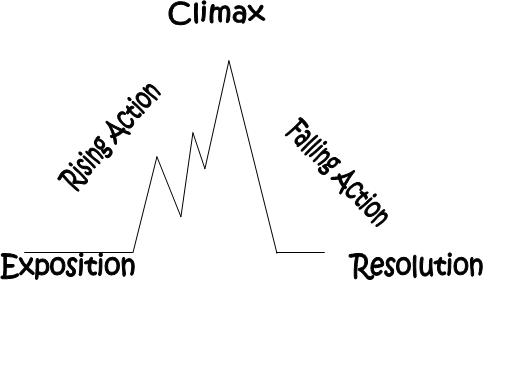Literature Links
Angela's Ashes by Frank McCourt
http://www.litlovers.com/reading-guides/13-fiction/59-angelas-ashes-mccourt?showall=1
An Interview with the Author
http://www.pbs.org/newshour/bb/entertainment/jan-june97/mccourt_4-7.html
Things You Should Know About Literature…
Elements of Fiction: Terms we use to discuss our reading
These terms include parts of literature and techniques that authors use to develop their stories.
Plot: The actions that make up the story. Most plots will follow the typical plot structure illustrated below.
Conflict: The major problem in the story
Common Types of conflict Found in Literature
- Person vs. Person
- Person vs. Self
- Person vs. Nature
- Person vs. Society
- Person vs. Destiny
- Person vs. Technology
Point of View: Perspective from which the story is told. The author can use a characters point of view to help develop the character. In order to understand point of view, you need to know what “narrator” means.
Narrator: The person or character who actually telling the story. This voice fills in the details for the reader between the sections dialogue.
1st Person: The writer uses “I” to tell the story
3rd Person: Someone outside the story is telling it
Omniscient: We know what all of the characters are thinking
Limited Omniscient: We only know what one character is thinking
Camera View: We don’t know what any of the characters are actually thinking
If you noticed 2nd person is missing, that is because 2nd person is “You,” when the writer is speaking directly to the reader. This usually happens in how-to books like cook books or instruction books.
Literary Devices
(Techniques Writers Can Use to Develop a Story)
Flashback: the author stops the plot and goes back in time to reveal important information
Foreshadowing: the clues that the author gives us about what's going to happen
Irony: when what you expect is not the same as the way something really is. An example of irony is a school cancels for a snow day, and there are record high temperatures that day
Mood: the atmosphere or feeling of a text (e.g. peaceful, hopeless, lonely, happy, sinister, suspenseful, exciting, optimistic, pessimistic, gloomy, sorrowful)
Moral: The lesson a story teaches
Setting: where and when the story occurs (time and place)
Symbol: something (a person, place, object, animal, or color) that usually can be extended to mean something more than its literal meaning
Theme: the big message or underlying meaning of the work
Tone: the writer’s attitude toward the subject in a literary work. Tone is conveyed through the choice of words to describe setting, portraying characters, and presenting events (e.g. formal, serious, humorous, angry, gloomy, ironic, imploring, matter-of-fact tone)
Notes about Characters in Fiction
Writers use Actions, Thoughts,
And Dialogue to Develop Their Characters
These are a few words that readers use to talk about characters in literature:
- Protagonist: the main character; usually the hero
- Antagonist: creates obstacles that the protagonist must overcome. As with protagonists, there may be more than one antagonist in a story. The antagonist is a force that works against the main character resolving a major conflict.
- Flat: a character who only displays one or two traits, not well-developed
- Round: a character with multiple traits, much more interesting, you feel like you
- Static: a character who does not change from the beginning to the end of a story
- Dynamic: a character who evolves throughout the story
Strategies Readers Use to Unlock Meaning
How do you know if you're "getting" it?
Create sensory images:
Good readers create a wide range of visual, auditory, and other sensory images as they read, and they become emotionally involved with what they read. Make a movie in your mind.
Use background Knowledge:
Figure out what you know before you start to read. Good readers use their relevant prior knowledge before, during, and after reading to enhance their understanding of what they’re reading. Activate your schema!
Ask questions:
Good readers generate questions before, during, and after reading to clarify meaning, make predictions, and focus their attention on what is important. What are you wondering about as your read?
Make inferences:
Good readers use their prior knowledge and information from what they read to make predictions, seek answers to questions, draw conclusions, and create interpretations that deepen their understanding of the text. The author and you are working together to make meaning.
Determine what is important in text:
You do not have to remember everything. Good readers identify key ideas or themes as they read, and they can distinguish between important and unimportant information.
Synthesize information:
Good readers track their inferential thinking as it evolves during reading to get the overall meaning.
Use “fix-up” strategies:
Don't just plow through. Good readers are aware of when they understand and when they don’t. If they have trouble understanding specific words, phrases or longer passages, they use a wide range of problem-solving strategies including skipping ahead, rereading, asking questions, summarizing, visualizing, predicting, building background knowledge, and using a dictionary.
